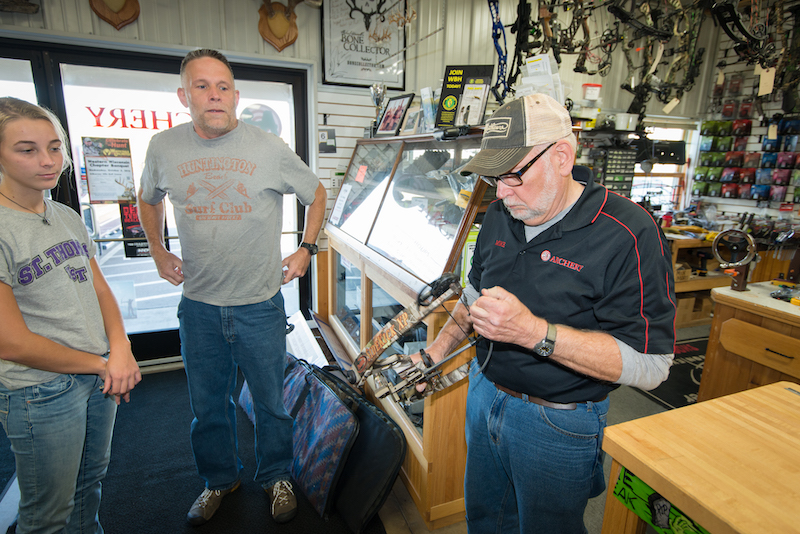If you want to give archery a try, you can find plenty of sensible ways to get started. Whether you visit a pro shop or work with a coach, it’s easy to find the best resources.
On the contrary, the wrong ways to get started aren’t as obvious, and that trap is easy to fall into for newbies. If you want to have a fun experience with a bow and arrow, the following methods are a great example of what not to do.
Skip the tuning process
A bow and arrow setup is entirely customized to the archer. The draw length and draw weight are fit specifically to the shooter. This setup directly affects which arrow spine you use, as this is cut and tuned to fit into the system. Hand-me-down bows can work great if the entire setup fits you perfectly. But if you adjust the draw length or weight at all, you risk throwing the entire setup out of tune. In many cases, this can lead to frustration at the range when your arrows don’t fly consistently.
If you have access to a hand-me-down bow, take it to a pro shop before shooting on your own. The draw weight and length on many bows is adjustable, and the shop can tweak it to create a custom fit for accurate shooting.
Don’t forget the hidden costs of a second-hand bow

You’ve scoured the internet in search of a used bow that’s new to you, and finally found a deal that’s almost too good to be true. Spoiler alert – like many things in life, if it seems too good to be true, it probably is. Used bows can be a great option, especially for a budget-minded archer, but there’s a few things to consider before you buy.
- Strings and cables: Examine the strings and cables carefully before you buy a used bow. If the strings look dry and worn, or the string servings are separated, they probably need to be replaced. This will raise your overall cost before you even start shooting.
- Shoot it first: You wouldn’t buy a bow from a pro shop without shooting it first, so why would your second-hand bow be any different? Ask the seller if you can take a few test shots before parting ways with your hard-earned cash. You’ll know right away whether you’re making a wise buying decision.
- Extra accessories: Take note of any additional accessories that are included with the bow. You’ll be able to estimate their value with a quick search online. In many cases, used bows offer archers a great opportunity to purchase a bow that’s entirely set up with a rest, sight, arrows and quiver. If the used bow you’re considering comes with everything you need to shoot, that adds a lot of value. If it doesn’t include any accessories, you’ll have to buy your own.
Shoot with the wrong draw weight or draw length

It doesn’t matter if you’re shooting a hand-me-down or the latest and greatest – if the bow doesn’t fit, you won’t shoot it well. If your draw weight is too heavy, you’ll fatigue easily and create bad habits when drawing your bow. Not only will you notice inconsistent arrow groups, you risk injuring yourself by pulling too much weight.
Generally, you should be able to draw your bow while sitting on a stool or chair with your feet hovering off the ground. If you have to aim into the sky and arch your back as you draw your bow, you’re pulling too much weight.
Understanding your bow’s draw length is another critical factor for repeatable accuracy. To estimate your draw length, measure your wingspan from fingertip to fingertip, subtract 15, and divide by two. When your draw length isn’t sized correctly, it’s hard to find a consistent anchor point. A draw length that’s too long causes your string to contact your arm when you release your arrow. This will cause you to throw arrows all over the place, and you’re likely to sustain a nasty bruise on your forearm. If you need to adjust your bow, visit your local pro shop.
Overestimate your DIY skills
Do-it-yourself projects are fun and rewarding. But unless you’re an expert with a bow press, don’t try to build or tune your own bow. You can find plenty of great videos that illustrate the process of setting up and tuning a bow, but the task requires specific equipment and know-how. You can do more harm than good when attempting to add an extra twist to your string, or secure a D-loop if you don’t know exactly how to tie it in. Once your rest is installed and cams are timed correctly, you can still enjoy the satisfaction of paper tuning the bow on your own. However, rather than investing time and money on a bow press, let your local pro shop get you pointed in the right direction.
Skip the fundamentals

Even the best gear on the market won’t shoot consistently if you’ve skimped on the fundamentals of archery. If you’ve been saving to buy a new bow but don’t know how to shoot, invest time and money into lessons at your local pro shop. Even if that means buying a more affordable bow to fund your lessons, you’ll shoot better and enjoy archery more when you understand the basics.
No matter what route you take to get started in archery, avoid these common mistakes like the plague. Ultimately, the archery community is made up of helpful, like-minded people who want you to succeed. If you run into questions along the way, don’t hesitate to reach out to the helpful experts at your local pro shop.




